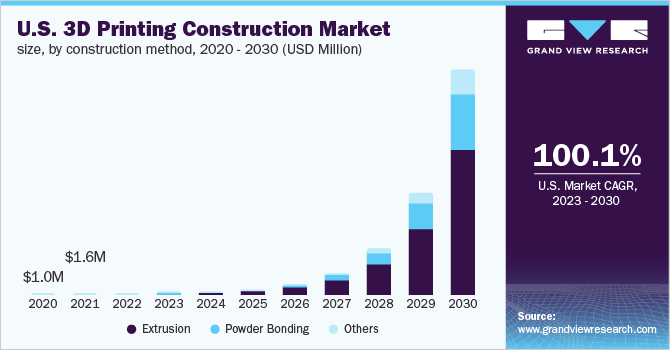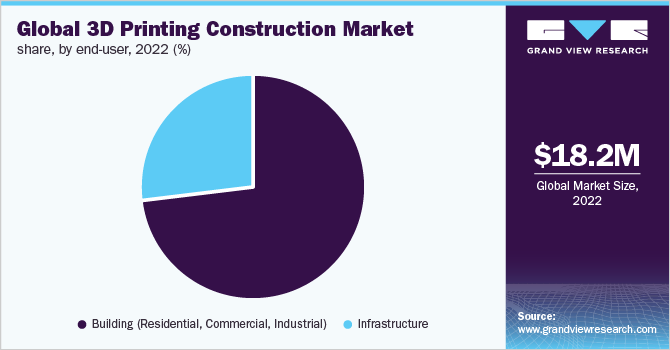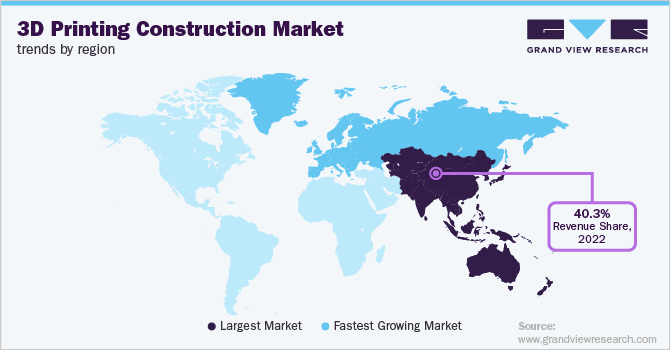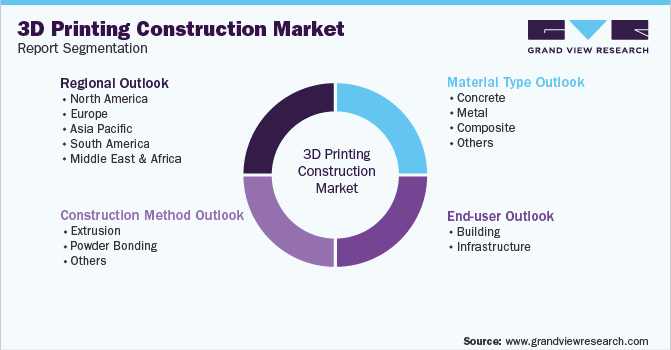- Home
- »
- Next Generation Technologies
- »
-
3D Printing Construction Market Size & Share Report, 2030GVR Report cover
![3D Printing Construction Market Size, Share & Trends Report]()
3D Printing Construction Market Size, Share & Trends Analysis Report By Construction Method (Extrusion, Powder Bonding), By Material Type (Concrete, Metal), By End-user (Building, Infrastructure), And Segment Forecasts, 2023 - 2030
- Report ID: GVR-4-68039-084-2
- Number of Report Pages: 150
- Format: PDF, Horizon Databook
- Historical Range: 2017 - 2021
- Forecast Period: 2023 - 2030
- Industry: Technology
Report Overview
The global 3D printing construction market size was valued at USD 18,175.7 thousand in 2022 and is projected to register a compound annual growth rate (CAGR) of 101.9% from 2023 to 2030. 3D printing technology enables the creation of customized and unique structures, making it ideal for bespoke building projects. A 3D printer produces layers of concrete, plastic, and metal, one layer at a time to build a structure. The constructed part created using the additive manufacturing process produces a highly precise and customizable structure at a faster speed with less waste. It is being widely used for constructing complex building structures using modeling software programs. The implementation of 3D printing technology offers high accuracy, improved efficiency, reduced labor cost, and greater speed. The growing adoption of 3D printers in the construction sector for prototyping, designing, & creating accurate end products and reducing manufacturing expenditure is driving the market growth.

Moreover, the rise in the adoption of green projects globally is also one of the major factors accentuating the market growth. Building construction businesses are increasingly using additive manufacturing and green construction methods to reduce costs and build energy-efficient buildings. Green construction refers to the practice of using sustainable processes and building materials to create buildings posing a negligible environmental impact. According to the World Green Building Trends Survey 2021, around 42% of the surveyed businesses planned that they would build about 60% of their projects using green technology by 2024. The market is projected to grow due to the increasing adoption of building information modeling (BIM).BIM provides a knowledge resource and collaborative platform for engineers, professionals, architects, and other stakeholders for efficient execution in designing, planning, and managing various decisions.
Furthermore, the growing construction sector in emerging countries, high emphasis on eco-friendly practices, and the need for affordable housing solutions are expected to drive the market growth over the forecast period. Governments of different countries and regional authorities & organizations are encouraging innovation in top sectors through initiatives, such as National Icons Competition, Innovation Expo, National Science Agenda, Innovation Attaché Network, and smart industrialization. These initiatives aim to strengthen industries by promoting the application and usage of cutting-edge technologies such as additive manufacturing, nanotechnology, and robots. In addition, various governments are also encouraging innovation through developments across public infrastructure and legislation, which can facilitate increased adoption.
Thus, the growing government efforts to promote 3D printing are projected to augment the market growth. However, the high capital investment associated with 3D printing construction is expected to hinder the market growth. Moreover, the materials used in commercial and industrial 3D printers are expensive compared to those used in traditional construction processes. In addition, factors, such as material constraints, limitations of the machinery, and concerns related to intellectual property rights, are projected to hinder market growth to a certain extent. The lack of skilled labor is also another major factor challenging the growth prospects of the market.
COVID-19 Impact Analysis
The outbreak of the COVID-19 pandemic adversely affected the growth of the global market. Several construction projects across the world are stalled as the outbreak of the pandemic has disrupted the supply of the raw materials used. The global market players experienced plummeting revenues in 2022. However, the extent of the decline would largely depend on the severity of the measures market players would initiate to offset the adverse impact of the pandemic. Additive manufacturing is experiencing a proper diffusion in different manufacturing industries and is likely to gain substantial adoption from the construction industry as well with the approaching time. The construction industry may get modified or affected by the technology as the trends are pointing towards the innovative printing of houses and buildings with concrete and the industry is focusing on the benefits of adopting the technology.
Initially, Europe and Asia Pacific were one of the worst affected regions in terms of the number of COVID-19 patients across the globe. Further, the situation worsened in the U.S. as well. Due to the rapid spread of the virus, the governments issued an order for the complete lockdown of some key cities. The complete lockdown affected the production of 3D printing manufacturers. This is attributed to the labor shortage and the complete disruption of logistics and supply chains in the nation. The halt in the production of 3D printing is having an adverse impact on the overall market growth in the first and second quarter of 2020. The quick prototyping and digital versatility of 3D printing offer rapid deployment of the technology and swift response to emergencies. Although there are severe disruptions in supply chains, essential parts can be fabricated on demand in several decentralized additive manufacturing facilities globally with the help of designs shared online.
Construction Method Insights
On the basis of construction methods, the global market has been further segmented into extrusion, powder bonding, and other (additive welding). The extrusion method segment dominated the market and accounted for the maximum revenue share of more than 62.4% in 2022.The segment is estimated to expand further at the fastest CAGR maintain its leading position throughout the forecast period. Extrusion 3D printing is also known as Fused Deposition Modeling, which is one of the additive manufacturing techniques used for prototyping, modeling, and production applications. The extrusion-based method is majorly used for on-site construction.
It allows the usage of traditional construction materials, such as geopolymer, concrete, cement, clay, and plaster. The powder bonding segment is also anticipated to register significant growth over the forecast period. The increasing use of powder bonding 3D-printing technology in the construction industry for constructing complex formworks is driving the segment growth. The demand for this method is high as it is faster, simpler, and more accurate to produce a complex formwork. In addition, this method is less labor-intensive and time-consuming compared to traditional methods used for making formworks.
Material Type Insights
The concrete material type segment dominated the market and accounted for the largest revenue share of more than 33.9% in 2022. 3D concrete printing is increasingly being used as an alternative to conventional concrete construction owing to its potential to reduce cost, labor, and time and increase overall productivity. According to the study conducted by AM and BigRep, the conventional concrete formwork requires highly skilled workers, which drives the process pricing up to 60% of the building’s total budget. However, with the use of 3D-printed concrete formworks, it is possible to create double-curved surfaces and organic geometry, among others, at a fraction of the cost.
Owing to these benefits, constructors are focused on developing 3D-printed concrete formwork. The metal segment is also expected to register significant growth over the forecast period. Metal 3D printing offers opportunities to create internal stiffening, non-prismatic sections, openings, and functionally graded elements, among others, through controlled heating and cooling. Metal 3D printing in construction is mainly used for designing facade nodes and other connections. Metal 3D printing is also being used for constructing bridges. In July 2022, the Dubai Municipality in UAE and Apis Cor, a U.S.-based company, collaborated to construct one of the largest 3d-printed structures. The double-story structure is constructed using a locally manufactured gypsum-based combination, measuring 9.5 meters in height and occupying an area of 640 square meters.
End-user Insights
The building segment dominated the market and accounted for a 72.8% share of the global revenue in 2022. The building segment comprises commercial, residential, and industrial construction. Various construction companies are entering into partnerships with 3D printer providers for constructing homes using 3D printing technology. For instance, in March 2021, 3Strandspartnered with ICON, a construction technology company. Through this partnership, the former company planned to leverage the 3D printing technology of ICON to develop two- to four-bedroom homes in Texas, one of the fastest-growing cities in the U.S.

The infrastructure segment is expected to register the fastest CAGR over the forecast period. The increasing use of 3D printing technology to construct infrastructures, such as furniture and bridges, using materials, such as metals, plastic, and composite, is driving the segment growth. Various initiatives undertaken by key companies across the world to build 3D-printed bridges are expected to drive the segment growth. For instance, in April 2021, Weber Beamix and BAM started constructing a 3D-printed concrete bridge for pedestrians in the Netherlands. This concrete structure will be 29.5 m in length. In addition, Weber Beamix plans to construct four more 3D-printed bridges across the Netherlands.
Regional Insights
The Asia Pacific region dominated the 3D printing construction market and accounted for a 40.3% share of the global revenue in 2022. The large market share and regional growth can be accredited to the lucrative opportunities in the construction sector in the Asia Pacific region. Moreover, as the region is establishing itself to become a global manufacturing hub, the technology is anticipated to gain significant traction over the forecast period. China and Japan are prominent countries with the potential to offer extensive opportunities for emerging and matured technologies, such as 3D printing construction.

The presence of numerous manufacturing industries is contributing to the region’s overall economic development. The market in the Europe region is expected to witness steady growth over the forecast period. Many market players in European countries, such as the U.K., are increasingly investing in 3D printing, thus propelling the regional market growth. For instance, in May 2020, Skanska, a construction engineering company, announced its collaboration with Lough borough University of the U.K. This collaboration was aimed to accelerate the use of 3D printing technology in the country’s construction sector.
Key Companies & Market Share Insights
The key players are focusing on expanding their businesses across different geographies and entering new untapped marketplaces in emerging countries to increase their customer base. The companies are also involved in the development of innovative products to cater to the growing consumer demands. In September 2022, COBOD International A/S, a Danish construction-technology company, collaborated with CEMEX S.A.B. de C.V., a Mexican cement maker, to accelerate 3D printing of houses using robots. Under this collaboration, CEMEX has developed additives for standard ready-mix concrete that can be used by builders to print homes using COBOD 3D printers.
The vendors are also entering into partnerships to strengthen their market position and offerings. For instance, in November 2020, CyBe Construction partnered with QOROX, a construction company from New Zealand, to 3D print concrete elements in the North Island city of Hamilton. The company made complex construction processes more sustainable through this partnership and provided 3D concrete printed park benches with unique technology. Some of the prominent players in the global 3D printing construction market include:
-
COBOD International A/S
-
Yingchuang Building Technique (Shanghai) Co.Ltd.(Winsun)
-
XtreeE
-
Apis Cor
-
WASP S.r.I
-
CyBe Construction
-
Sika AG
-
MX3D
-
Contour Crafting Corp.
-
ICON Technology, Inc.
-
Constructions-3D
3D Printing Construction Market Report Scope
Report Attribute
Details
Market size value in 2022
USD 18,175.7 thousand
Revenue forecast in 2030
USD 4,179.3 million
Growth rate
CAGR of 101.9% from 2023 to 2030
Base year of estimation
2022
Historical data
2017 - 2021
Forecast period
2023 - 2030
Quantitative units
Revenue in USD thousand and CAGR from 2023 to 2030
Report coverage
Revenue forecast, company market share, competitive landscape, growth factors, and trends
Segments covered
Construction method, material type, end-user, region
Regional scope
North America; Europe; Asia Pacific; South America; MEA
Country scope
U.S.; Canada; Mexico; U.K.; Germany; France; China; South Korea; Japan; Brazil; Saudi Arabia/KSA
Key companies profiled
COBOD International A/S; Yingchuang Building Technique (Shanghai) Co.Ltd.(Winsun); XtreeE; Apis Cor; WASP S.r.I; CyBe Construction; Sika AG; MX3D; Contour Crafting Corporation; ICON Technology, Inc.; and Constructions-3D
Customization scope
Free report customization (equivalent up to 8 analysts working days) with purchase. Addition or alteration to country, regional,and segment scope
Pricing and purchase options
Avail customized purchase options to meet your exact research needs. Explore purchase options
Segments Covered in the ReportThis report forecasts revenue growth at global, regional, and country levels and provides an analysis of the industry trends in each of the sub-segments from 2017 to 2030. For the purpose of this study, Grand View Research has segmented the global 3D printing construction market report on the basis of construction method, material type, end-user, and region:

-
Construction Method Outlook (Revenue, USD Thousand, 2017 - 2030)
-
Extrusion
-
Powder Bonding
-
Others
-
-
Material Type Outlook (Revenue, USD Thousand, 2017 - 2030)
-
Concrete
-
Metal
-
Composite
-
Others
-
-
End-user Outlook (Revenue, USD Thousand, 2017 - 2030)
-
Building
-
Infrastructure
-
-
Regional Outlook (Revenue, USD Thousand, 2017 - 2030)
-
North America
-
U.S.
-
Canada
-
Mexico
-
-
Europe
-
U.K.
-
Germany
-
France
-
-
Asia Pacific
-
China
-
Japan
-
South Korea
-
-
South America
-
Brazil
-
-
Middle East & Africa
-
Saudi Arabia/KSA
-
-
Frequently Asked Questions About This Report
b. The extrusion segment dominated the 3D printing construction market and accounted for more than 62% share of the global revenue in 2021.
b. Key factors that are driving the 3D printing construction market growth include increasing use of 3D printing for infrastructure & the building sector, reduction in manufacturing expenditure, and accuracy in the end-product.
b. The global 3D printing construction market size was estimated at USD 11,268.9 thousand in 2021 and is expected to reach USD 18,956.9 thousand in 2022
b. The global 3D printing construction market is expected to grow at a compound annual growth rate of 100.7% from 2022 to 2030 to reach USD 4,986,793.7 thousand by 2030
b. Some key players operating in the 3D printing construction market include COBOD International A/S; Yingchuang Building Technique (Shanghai) Co.Ltd.(Winsun); XtreeE; Apis Cor; WASP S.r.I; CyBe Construction; Sika AG; MX3D; Contour Crafting Corporation; ICON Technology, Inc.; and Constructions -3D.
Share this report with your colleague or friend.
![gvr icn]()
NEED A CUSTOM REPORT?
We can customize every report - free of charge - including purchasing stand-alone sections or country-level reports, as well as offer affordable discounts for start-ups & universities. Contact us now
![Certified Icon]()
We are GDPR and CCPA compliant! Your transaction & personal information is safe and secure. For more details, please read our privacy policy.
We are committed towards customer satisfaction, and quality service.
"The quality of research they have done for us has been excellent."





